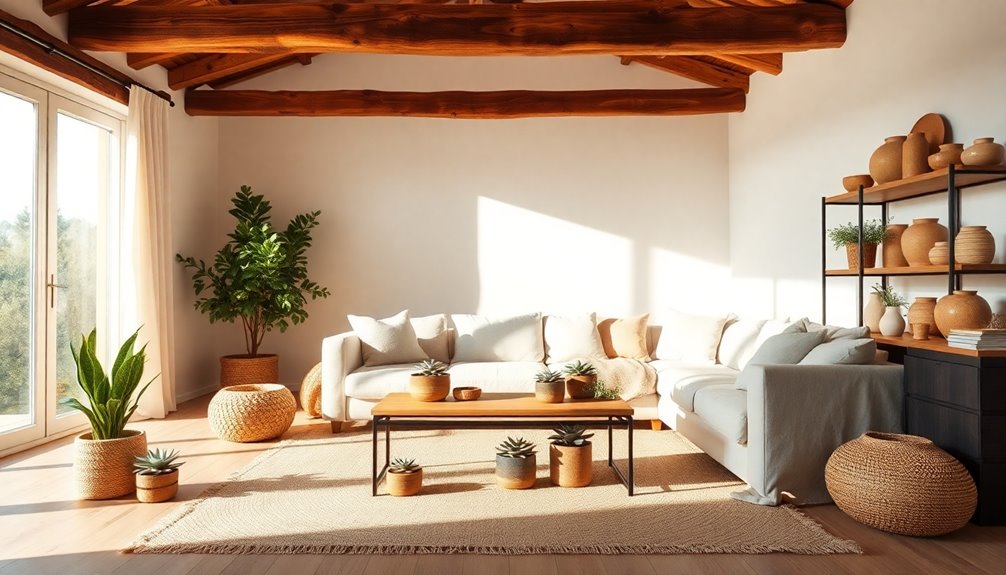Sustainable home decor materials like reclaimed wood, bamboo, and organic cotton offer you eco-friendly choices that reduce your carbon footprint and enhance indoor air quality. By opting for renewable resources and low-VOC finishes, you're not just creating a stylish space; you're supporting local economies and promoting healthier living. Consider upcycling old furniture or selecting textiles made from jute and hemp to minimize waste. Plus, energy-efficient options like LED bulbs and smart thermostats can considerably lower your utility bills. There's so much more you can explore to make your home greener and stylish.
Key Takeaways
- Choose renewable materials like bamboo and cork for furniture and flooring to promote sustainability and reduce environmental impact.
- Incorporate reclaimed wood in decor to add character while minimizing deforestation and waste.
- Opt for low-VOC paints and finishes to enhance indoor air quality and create a healthier living environment.
- Support local artisans and seek products with FSC and GOTS certifications to ensure responsible sourcing and bolster local economies.
- Utilize energy-efficient appliances and smart home technologies to reduce energy consumption and lower utility bills in your home.
Importance of Sustainable Materials
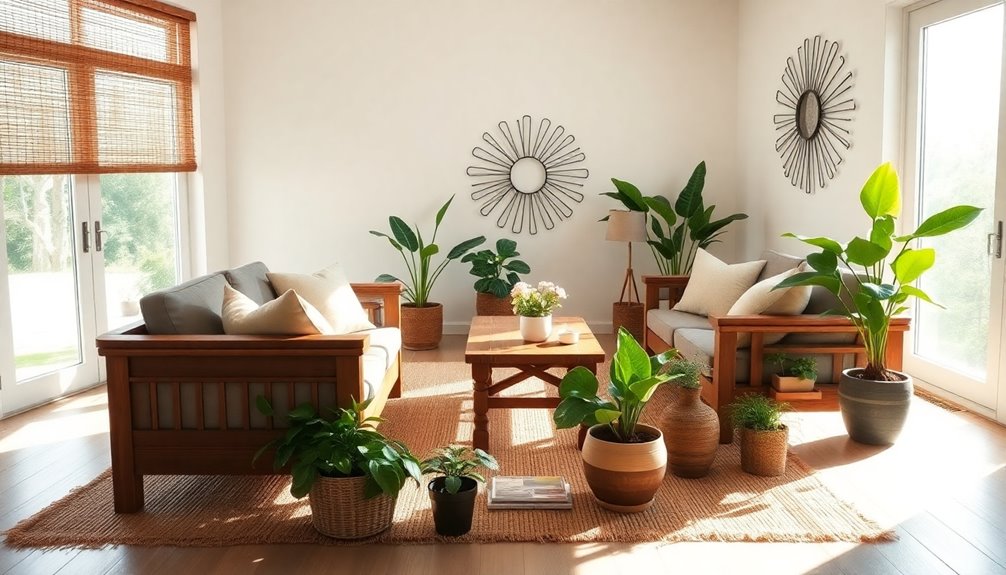
Sustainable materials play an essential role in transforming your home into an eco-friendly sanctuary. By choosing sustainable materials like reclaimed wood and bamboo, you greatly reduce environmental impact while promoting renewable resources. Incorporating eco-friendly materials, such as organic cotton and recycled metals, not only supports local economies but also encourages responsible sourcing practices. Using low-VOC paints and finishes enhances your indoor air quality, eliminating harmful substances often found in conventional products. Additionally, investing in durable materials guarantees your decor lasts longer, leading to reduced waste over time. Moreover, employing energy-efficient designs promotes a greener lifestyle by minimizing electricity consumption while maintaining optimal functionality. Furthermore, utilizing sustainably sourced wood for decor elements can further support eco-friendly living by reducing reliance on fossil fuels. This approach aligns with the principles of sustainable materials in home decor, ensuring your choices contribute positively to the environment. Incorporating materials like reclaimed wood can add rustic charm while also being environmentally responsible.
Benefits of Eco-Friendly Choices
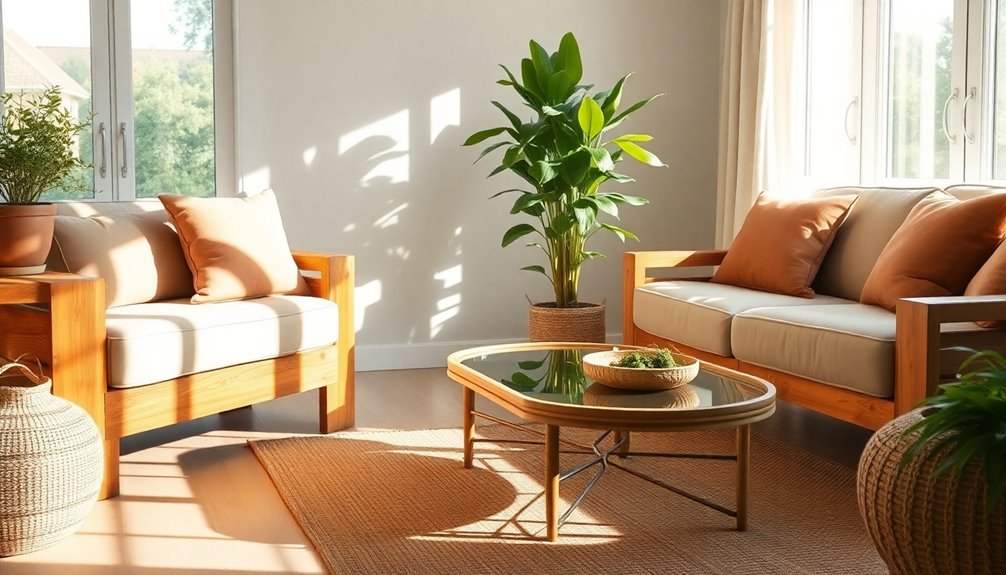
Choosing eco-friendly materials not only benefits the planet but also enhances your home in numerous ways. By opting for sustainable decor, you greatly reduce your carbon footprint while enjoying the beauty of natural fibers like bamboo and reclaimed wood. Incorporating traditional Indonesian style home decor can further highlight the use of sustainable materials in your design. Additionally, investing in gold IRAs can provide financial stability, allowing you to focus on sustainable living without financial stress.
Using low-VOC paints and finishes improves indoor air quality, promoting healthier living for you and your family. Plus, investing in durable products means you won't have to replace items frequently, leading to long-term cost savings. Incorporating natural materials such as wood and stone in your decor can also enhance the beauty and authenticity of your space.
Eco-friendly home decor also supports local businesses that prioritize sustainable practices, fostering community empowerment. With these choices, you create a stylish, energy-efficient space that reflects your commitment to a greener lifestyle.
Additionally, incorporating natural elements into your decor can further enhance the tranquility of your home. Embrace eco-friendly options and enjoy a home that's both beautiful and responsible.
Types of Sustainable Materials
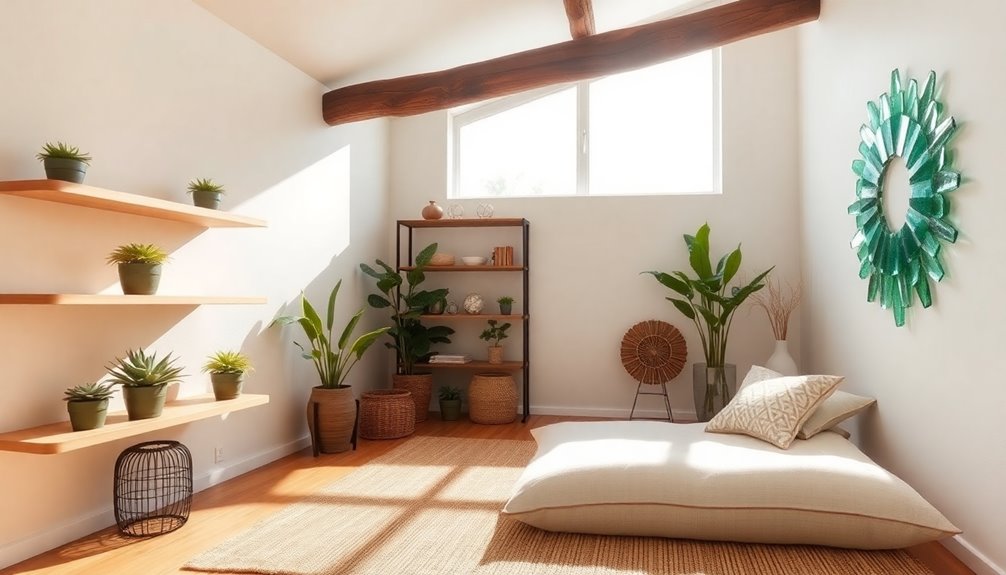
When choosing sustainable materials for your home, you'll find several excellent options that are both eco-friendly and stylish.
Renewable resources like bamboo and cork offer durability while being kind to the planet. Additionally, incorporating Indonesian decor masks made from sustainable materials can enhance both your decor and cultural appreciation. Notably, many interior design shops in Bali, such as Mahallati Interiors, specialize in integrating sustainable materials into their luxury designs. Moreover, using herbal alternatives for beauty enhancements aligns with a sustainable lifestyle while promoting skin health.
Meanwhile, recycled materials and natural fibers like hemp and jute provide unique aesthetics and minimize environmental impact. Additionally, using materials such as reclaimed wood can add character to your decor while helping to reduce deforestation.
Renewable Resource Options
As you explore eco-friendly decor options, you'll find that renewable resource materials offer an array of stylish and sustainable choices for your home.
Bamboo, a fast-growing renewable resource, is perfect for flooring and furniture, maturing in just three to five years. Its versatility also makes it a great choice for modern farmhouse decor. Additionally, bamboo's strength and durability make it an excellent alternative to traditional wood options.
Cork, harvested from the bark of cork oak trees, provides sustainable options without harming the trees.
Consider incorporating reclaimed wood for a unique touch that reduces waste and preserves forests.
For durable furniture and accents, recycled metal appreciably lowers energy consumption during production.
Finally, natural fibers like hemp and jute are biodegradable and require minimal pesticides, making them excellent organic materials for textiles and rugs.
These options create a greener home while showcasing your commitment to sustainability. Additionally, incorporating routine health checks can help ensure the longevity of your eco-friendly materials by preventing damage from pests or environmental factors.
Recycled Material Benefits
Recycled materials offer numerous benefits for those looking to create a sustainable home environment. By incorporating these eco-friendly options, you can reduce waste and lower your carbon footprint. For example, using recycled glass and plastics in your home decor can divert waste from landfills while conserving natural resources. Plus, products made from reclaimed wood or recycled metal often boast unique aesthetics, appealing to eco-conscious consumers who value distinctive decor. Additionally, utilizing recycled materials can contribute to LEED certification points, enhancing your property's value. Furthermore, embracing eco-conscious choices can foster a sense of community and connection, similar to how humor in texting bridges generational gaps among seniors. The use of recycled materials not only supports sustainable practices but also aligns with the growing trend of eco-friendly living. Moreover, products made from organic farms can further enhance the sustainability of your home decor. The organic tea market is also projected to grow, reflecting the increasing consumer interest in sustainable products across various industries.
| Benefit | Description |
|---|---|
| Reduce Waste | Diverts materials from landfills |
| Conserve Natural Resources | Saves trees, water, and energy |
| Unique Aesthetics | Adds character and history to decor |
| Environmentally Friendly | Lowers carbon footprint |
| Sustainable Interior Design | Supports eco-conscious choices in home decor items |
Natural Fiber Choices
Incorporating sustainable materials into your home decor goes beyond just recycled options; natural fibers also play a significant role. Options like organic cotton, linen, hemp, and jute are excellent choices for an eco-friendly home. Organic cotton is grown without synthetic pesticides, making it safer for the environment and your indoor air quality. Linen, derived from the flax plant, uses less water and energy than conventional cotton, thereby reducing its environmental impact. Additionally, high-density herb zones are a concept in herbalism that emphasizes efficient resource use, which parallels the idea of maximizing sustainability in home decor. Furthermore, using essential oils derived from plants can enhance the ambiance of your sustainable home while promoting well-being.
Hemp is remarkably fast-growing and requires minimal pesticides, offering strong, durable fibers that resist mold and UV light. Jute, often found in rugs and textiles, is a renewable resource that improves soil health. Additionally, incorporating natural materials like wood and stone can further enhance the eco-friendly aesthetic of your home.
Supporting Artisan and Local Brands
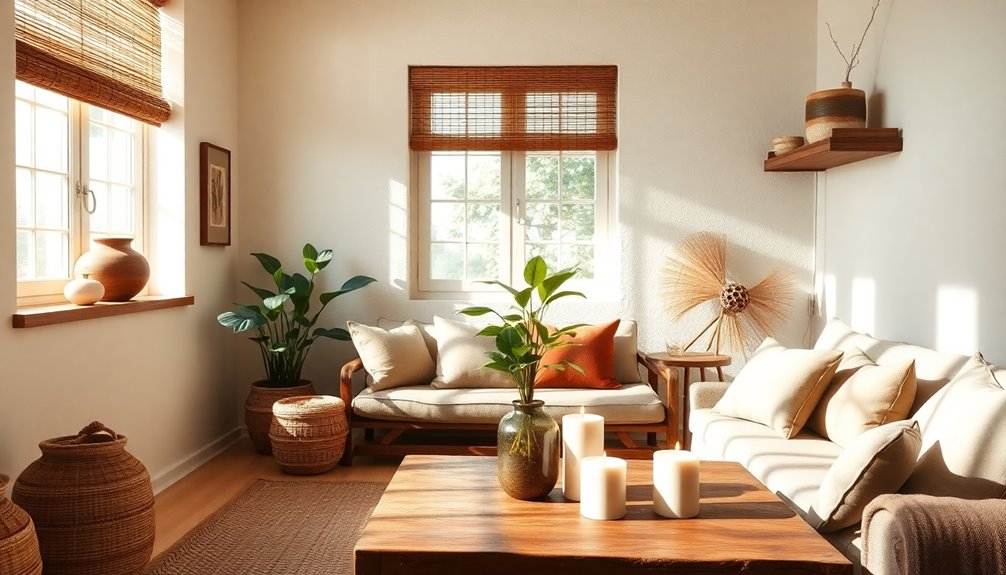
When you support artisan and local brands, you empower skilled craftspeople and help preserve traditional techniques.
This choice not only contributes to their livelihoods but also boosts local economies, creating a more sustainable community.
Artisan Empowerment Initiatives
Supporting artisan and local brands not only enhances your home decor but also uplifts communities around the globe. By choosing products from artisan empowerment initiatives, you contribute to sustainable practices that prioritize fair trade and ethical sourcing.
Here are some benefits of supporting these initiatives:
- Access to unique, handcrafted home decor that showcases cultural craftsmanship
- Assurance that your purchases are ethically made and promote community initiatives
- Support for sustainable materials and fair wages for artisans
Brands like Ten Thousand Villages and The Citizenry exemplify these values, ensuring that artisans thrive while you enjoy eco-friendly choices in your space.
Local Economic Growth
Choosing artisan and local brands not only enriches your home decor but also fuels local economic growth. When you support local artisans, you create jobs and empower small businesses, leading to vibrant community economic growth.
By investing in local decor, you're also using sustainable materials that reflect the region's cultural heritage. This practice helps reduce your carbon footprint through minimized transportation emissions.
Brands like Made Trade emphasize ethical practices, ensuring artisans receive fair wages and that profits benefit the local economy. Collaborations with companies like Anthropologie further preserve traditional crafts while expanding artisans' market access.
Embrace sustainable living by curating unique home environments that celebrate craftsmanship and support local artisans—your choices make a significant impact!
Upcycling and Repurposing Ideas
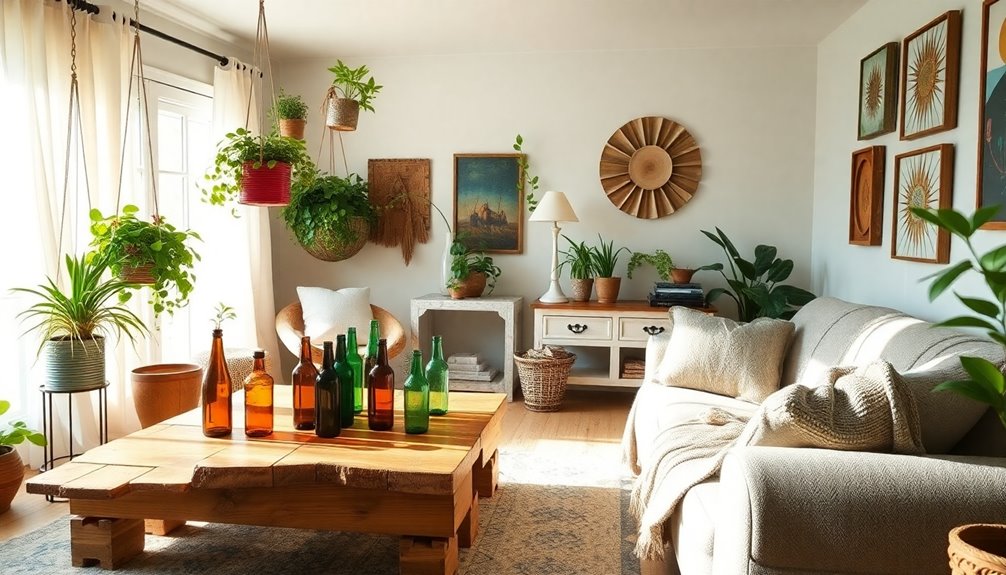
Upcycling and repurposing breathe new life into everyday items, transforming them into functional and stylish home decor. By engaging in these practices, you not only reduce waste but also embrace resourcefulness and creativity.
Here are some ideas to get you started:
- Turn old furniture into stunning statement pieces with eco-friendly paint or new upholstery.
- Repurpose glass jars into decorative vases or storage containers, adding a rustic charm to your space.
- Combine fabric scraps to create unique decorative pillows or patchwork quilts.
These upcycling and repurposing ideas promote sustainable materials while minimizing landfill waste.
Energy Efficiency in Home Decor
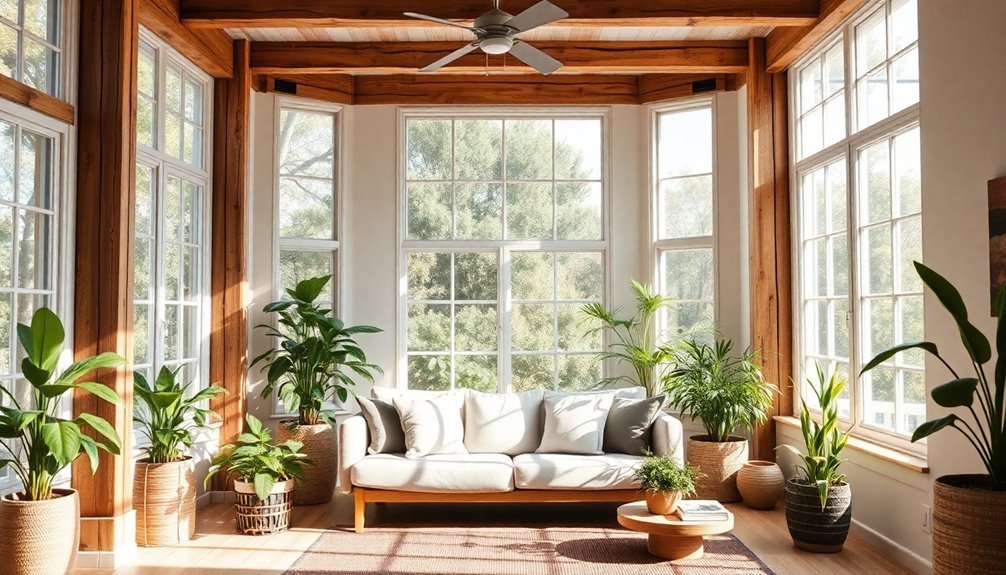
How can you create a stylish home while saving energy?
Start by embracing energy efficiency with LED bulbs, which use up to 75% less energy and last 25 times longer than incandescent bulbs.
To further reduce your energy consumption, install energy-efficient windows that minimize heat loss and gain, potentially lowering bills by 15-30%.
Smart thermostats are another eco-friendly choice, optimizing heating and cooling based on your habits and cutting costs by 10-15%.
Consider thermal blackout window treatments to enhance insulation, which can lead to a 25% reduction in heating and cooling costs.
Finally, outfit your space with Energy Star-rated appliances, saving 10-50% more energy than standard options.
These choices combine style with sustainability!
Sustainable Textiles for Your Home
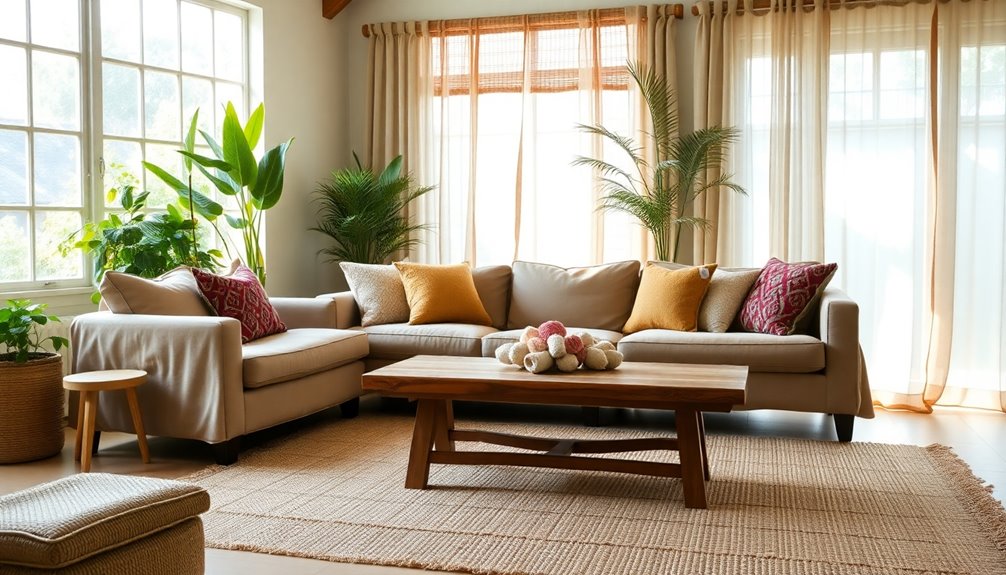
Incorporating sustainable textiles into your home decor not only enhances your space's style but also supports a healthier environment. By choosing eco-friendly options, you can improve indoor air quality while embracing beautiful design.
Consider these sustainable textiles:
- Organic cotton and linen for their biodegradable properties.
- Natural fiber rugs that are free from harmful chemicals.
- Handcrafted homewares from brands like MINNA, supporting artisan communities.
Brands like Coyuchi and Parachute Home guarantee ethical labor practices, while Woven repurposes recycled materials, contributing to a circular economy.
Opting for non-toxic materials and sustainable textiles not only beautifies your home but also promotes a greener planet. Make choices that reflect your values and create a nurturing environment for you and your loved ones.
Mindful Shopping Practices
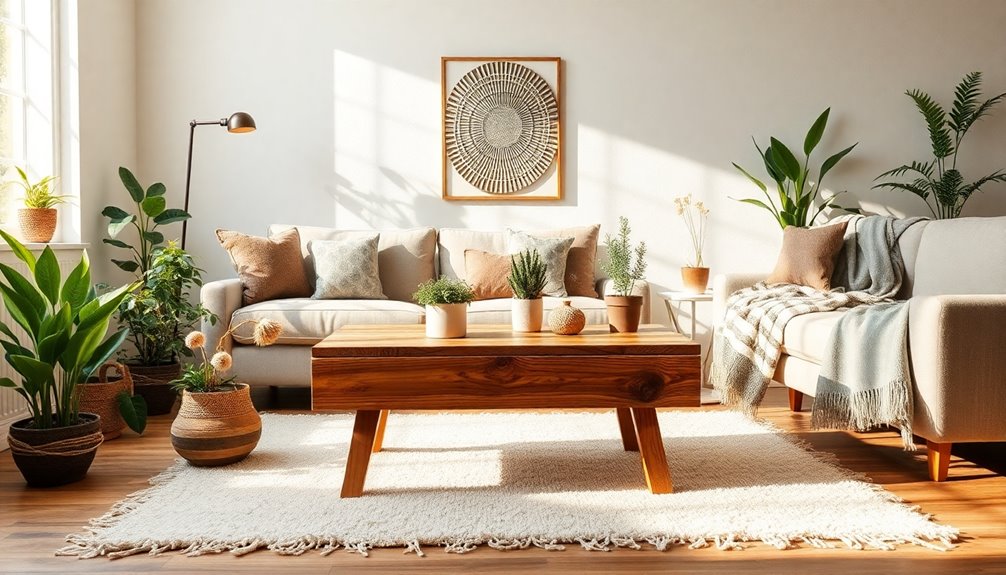
When you commit to mindful shopping practices, you not only enhance your home decor but also contribute to a healthier planet. By choosing sustainable materials like reclaimed wood and recycled metals, you help reduce waste. Look for eco-friendly certifications such as FSC and GOTS to guarantee responsible sourcing. Supporting local artisans strengthens community ties and promotes fair trade.
Here's a quick guide to mindful shopping:
| Practices | Benefits |
|---|---|
| Upcycling | Reduces waste |
| Transparent supply chains | Informed choices |
| Energy-efficient products | Lower environmental impact |
Prioritize these elements in your shopping journey, and enjoy a stylish home while making a positive impact!
Frequently Asked Questions
How Can I Make My Home More Green or Sustainable?
You can make your home more green or sustainable by starting with small changes.
Choose energy-efficient appliances and switch to LED lighting to cut down on energy use.
Use low-VOC paints to improve air quality.
Consider upcycling old furniture into something new, which reduces waste and sparks creativity.
Finally, support brands with eco-friendly certifications to guarantee your purchases align with sustainable practices.
Every little step counts toward a greener lifestyle!
What Material Is More Eco-Friendly?
Choosing eco-friendly materials is like picking the freshest fruits at a market; it's all about quality and sustainability.
Bamboo stands out for its rapid growth, making it a renewable superstar.
Reclaimed wood adds character while reducing deforestation, and cork's bark-harvesting process keeps trees thriving.
Recycled metals drastically cut energy use, and natural fibers like hemp and jute are gentle on the environment.
Each option contributes to a healthier planet, so you can't go wrong!
What Are Examples of Eco-Friendly Designs?
When you think about eco-friendly designs, there are several great examples to evaluate.
You might use reclaimed wood for furniture, which adds character while reducing waste. Bamboo is another option, perfect for flooring or decor since it grows quickly and renewably.
Don't forget natural fibers like hemp or jute for textiles, and low-VOC paints can enhance your walls without harming air quality.
Vintage or upcycled items also lend a unique touch to your space.
How Do You Make Eco-Friendly Decorations?
Imagine vibrant textiles woven from organic cotton, breathing life into your space.
To make eco-friendly decorations, you'll start by sourcing sustainable materials like reclaimed wood or bamboo. Incorporate natural fibers for textiles, and choose low-VOC paints to refresh your walls.
Don't forget to repurpose items you already own—turn glass jars into charming vases or stitch old fabric into unique pillows.
Each piece you create not only looks beautiful but also tells a story of sustainability.
Conclusion
By choosing sustainable home decor materials, you're planting seeds for a greener future. Each eco-friendly choice you make nurtures not just your space but the planet, creating a vibrant tapestry of life that benefits us all. Remember, every small decision counts, like drops of water that fill an ocean. Embrace mindful shopping, support local artisans, and explore the beauty of upcycling. Together, we can transform our homes into sanctuaries that reflect our commitment to a healthier world.
